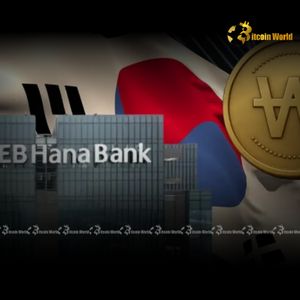Korean Won Stablecoin: Hana Bank’s Revolutionary Move in South Korea’s Digital Finance Landscape
6 min read
BitcoinWorld Korean Won Stablecoin: Hana Bank’s Revolutionary Move in South Korea’s Digital Finance Landscape The world of digital currency is experiencing an unprecedented surge, and South Korea, a global leader in technological adoption, is at the forefront of this evolution. Imagine a digital currency that offers the stability of your national fiat, yet boasts the speed and efficiency of blockchain technology. This is the promise of the Korean won stablecoin , and major financial players are now making their move. Recently, Hana Bank, one of South Korea’s largest and most respected financial institutions, announced its pursuit of trademark rights related to stablecoins. This isn’t just a corporate formality; it’s a powerful signal of a pivotal shift in the nation’s digital finance landscape, following similar proactive steps by other banking giants. The Race for a Korean Won Stablecoin Begins Hana Bank’s decision to pursue trademark rights for stablecoins marks a significant milestone in South Korea’s embrace of digital assets. According to local reports from Asia Today, the bank has filed for a substantial 16 trademarks specifically related to Korean won-based stablecoins. This strategic move positions Hana Bank alongside other prominent financial entities like KB Kookmin Bank and KakaoBank, the innovative digital banking arm of the messaging platform Kakao, both of whom have already ventured into this exciting space. But what exactly is a stablecoin, and why is a won-based version so important? What is a Stablecoin? At its core, a stablecoin is a type of cryptocurrency designed to minimize price volatility. Unlike Bitcoin or Ethereum, whose values can fluctuate wildly, stablecoins are typically pegged to a stable asset, such as a fiat currency (like the US dollar or Korean won), gold, or even other cryptocurrencies. This pegging provides a reliable medium for transactions, making them ideal for everyday use and financial applications. Why a Won-Based Stablecoin? A stablecoin pegged to the Korean won offers several compelling advantages for the domestic market. It combines the stability of the national currency with the benefits of blockchain technology, such as faster transaction speeds, lower fees, and enhanced transparency. This could revolutionize everything from daily payments to international remittances, offering a digital equivalent of cash that is easily transferable and programmable. Hana Bank ‘s Strategic Partnerships and Vision Hana Bank isn’t just filing trademarks; it’s actively building the infrastructure for a future where digital won transactions are commonplace. The bank is reportedly working in close cooperation with the Open Blockchain & Decentralized Identifier Association (OBDIA) to establish a joint venture. This collaboration is specifically aimed at launching a Korean won-based stablecoin, indicating a commitment beyond mere exploration. OBDIA’s expertise in blockchain and decentralized identity solutions makes them an ideal partner for such an ambitious undertaking. This initiative highlights a broader trend among traditional financial institutions: rather than resisting the tide of digital transformation, they are choosing to lead it. By forming alliances with blockchain-focused organizations, banks like Hana Bank are leveraging cutting-edge technology to innovate their services. This contrasts with the earlier, more cautious approach many traditional banks took towards cryptocurrencies, often viewing them as a threat. Now, they see the immense potential for efficiency, new revenue streams, and improved customer experiences that digital assets, particularly stablecoins, can offer. The active participation of a major player like Hana Bank signals a robust and collaborative approach to stablecoin development in South Korea. What This Means for South Korea’s Digital Finance Future The entry of major banks into the stablecoin arena has profound implications for South Korea’s digital finance landscape. South Korea has always been a nation quick to adopt new technologies, from high-speed internet to advanced mobile payments. This proactive stance on stablecoins aligns perfectly with its innovative spirit. The development of a widely adopted Korean won stablecoin could: Enhance Payment Systems: Imagine instant, low-cost payments for goods and services, both online and offline. A won stablecoin could streamline domestic transactions, reducing reliance on traditional, often slower, payment rails. Boost Cross-Border Transactions: International remittances and trade finance could become significantly more efficient and less expensive. This could particularly benefit South Korea’s export-oriented economy. Spur Innovation in DeFi: While stablecoins are often seen as a bridge to traditional finance, they also serve as a crucial component of decentralized finance (DeFi). A regulated, bank-backed stablecoin could bring greater legitimacy and liquidity to Korea’s emerging DeFi ecosystem. Complement CBDC Discussions: The Bank of Korea has been exploring a central bank digital currency (CBDC). Private sector stablecoins, especially those backed by major banks, could either complement a CBDC by handling retail payments, or even serve as a robust alternative depending on the regulatory framework. This interplay between public and private digital currencies will define South Korea’s digital finance trajectory. Unpacking Stablecoin Development : Benefits and Hurdles The journey of stablecoin development, especially when spearheaded by traditional banks, comes with a unique set of benefits and challenges. Understanding these dynamics is crucial for appreciating the significance of Hana Bank’s move. Benefits: Benefit Description Efficiency & Speed Blockchain-based transactions are typically faster and cheaper than traditional bank transfers, especially across borders. Accessibility Stablecoins can lower barriers to financial services, potentially reaching the unbanked or underbanked populations. Programmability The underlying blockchain technology allows for smart contracts, enabling automated payments, escrow services, and innovative financial products. Transparency Transactions on a public blockchain are auditable, enhancing trust and reducing fraud, though privacy considerations remain important. Challenges: Regulatory Clarity: The biggest hurdle remains the evolving regulatory landscape. Governments worldwide are grappling with how to classify and oversee stablecoins, particularly those issued by private entities. Clear guidelines on consumer protection, anti-money laundering (AML), and combating the financing of terrorism (CFT) are essential. Technological Integration: Integrating new blockchain-based systems with existing legacy banking infrastructure is a complex and costly endeavor. Ensuring seamless interoperability and scalability is vital for mass adoption. Public Trust & Education: Despite their stability, stablecoins are still a relatively new concept for the general public. Building trust and educating users about their benefits and risks will be critical for widespread adoption. Competition: The market is becoming increasingly crowded with various stablecoin projects and potential CBDCs. Banks must differentiate their offerings and demonstrate clear value propositions to users. The success of stablecoin development hinges on navigating these complexities effectively. Driving Financial Innovation Beyond Traditional Banking Hana Bank’s foray into Korean won stablecoins represents more than just a new product offering; it signifies a fundamental shift in how traditional banks perceive and engage with emerging technologies. For decades, banks have been the gatekeepers of finance, operating within established frameworks. However, the rise of blockchain and digital assets has challenged this paradigm, prompting a necessary evolution. This move by Hana Bank is a prime example of proactive financial innovation . Instead of being disrupted, they are embracing the disruptive potential of stablecoins to create new value. This could lead to: New Revenue Streams: Beyond traditional lending and deposit services, banks could generate revenue from stablecoin issuance, transaction fees, and new digital asset-based financial products. Enhanced Customer Experience: Faster, cheaper, and more accessible financial services could significantly improve customer satisfaction and attract a new generation of digitally native users. Redefined Role of Banks: Banks could evolve from being mere intermediaries to becoming trusted digital asset custodians, infrastructure providers for tokenized economies, and facilitators of decentralized finance. The collaboration with OBDIA also underscores the importance of partnerships in this new era. No single entity can build the future of finance alone. By combining their vast financial experience with the technical prowess of blockchain specialists, banks like Hana Bank are setting a precedent for collaborative innovation that pushes the boundaries of traditional banking. A New Era for Korean Finance Hana Bank’s pursuit of Korean won-based stablecoin trademarks is a clear indication of the accelerating pace of digital transformation in the financial sector. This strategic move, mirroring actions by other major institutions, not only positions Hana Bank as a forward-thinking leader but also signals a collective effort within South Korea to embrace the future of money. While challenges remain, particularly around regulation and technological integration, the potential benefits—from enhanced payment efficiency to new avenues for financial innovation—are immense. As these developments unfold, South Korea is poised to solidify its position as a global hub for digital finance, shaping how we transact, invest, and interact with money in the years to come. To learn more about the latest digital finance trends, explore our article on key developments shaping stablecoin adoption and institutional involvement. This post Korean Won Stablecoin: Hana Bank’s Revolutionary Move in South Korea’s Digital Finance Landscape first appeared on BitcoinWorld and is written by Editorial Team

Source: Bitcoin World



